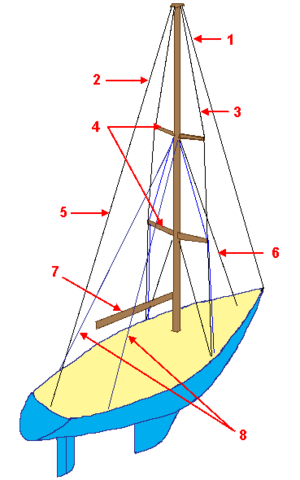Rigging facts for kids
The rigging on a sailing ship is all the ropes, wires, and chains that help hold up the ship's masts, yards, and sails. Think of it as the strong framework that keeps the sails working. There are two main types of rigging: standing rigging and running rigging.
- Standing rigging helps support the masts. It keeps them strong and upright.
- Running rigging helps control the yards and sails. It lets sailors move the sails to catch the wind.
Some sailboats have masts that don't need much support. These boats, like the junk rig or catboat, have very little or no rigging. Other boats, like Bermuda sloops, have simple rigging. Large ships such as cutter-rigged ketches and schooners have the most complex rigging systems.
Contents
Standing Rigging: Keeping Masts Strong
A sailing ship's standing rigging is made of ropes, wires, or rods. These parts are used to support the masts, yards, and booms. Most modern sailing vessels use strong wire rope for their standing rigging.
Sailors regularly check the tension of modern standing rigging. They use a special tool called a gauge for this. They can adjust the tension using a device called a turnbuckle. Ropes, wires, or rods that run from the front to the back of the ship are called stays. These stays help keep the masts or spars stable.
- Forestays run from the mast to the front of the ship.
- Backstays run from the mast to the back of the ship.
Running Rigging: Controlling the Sails
The running rigging on a sailing vessel helps sailors control the sails. This rigging is usually made up of different kinds of rope, which sailors often call "lines." It uses special tools called blocks and sheaves to adjust the length of the ropes.
- A block is like a pulley.
- A sheave is the grooved wheel inside the block.
Larger sailing boats and ships also use winches to help pull the ropes. Being able to adjust the running rigging lets the boat perform different moves. These moves include tacking (turning the front of the boat through the wind) and jibing (turning the back of the boat through the wind).
Two common parts of running rigging on all sailboats are the outhaul and the downhaul.
- The outhaul pulls the sail to the end of the boom.
- The downhaul keeps the boom from rising up the mast.
Images for kids
-
The rigging of a square rigger in London.
-
Bermuda rigged sloop at Convict Bay, Bermuda, around 1879.
See also
 In Spanish: Aparejo (náutica) para niños
In Spanish: Aparejo (náutica) para niños






